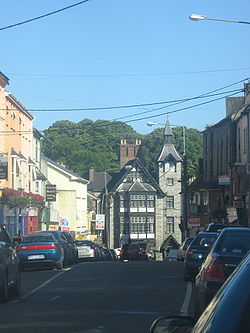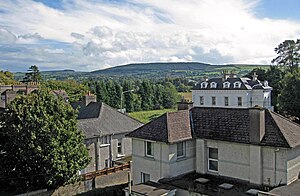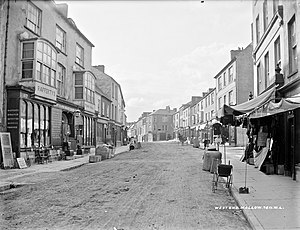Mallow: Difference between revisions
No edit summary |
m →Road: clean up |
||
| Line 41: | Line 41: | ||
===Road=== | ===Road=== | ||
Mallow lies at the convergence of several important routes: National Primary Route 20 (N20) north-south road between [[Cork]] (22 miles) and [[Limerick]] (44 miles), National Secondary Route 72 (N72) east-west between [[Dungarvan]] (32 miles) and [[Killarney]] (26 miles), National Secondary Route 73 (N73) north-east to [[Mitchelstown]] and the [[M8 motorway (Ireland)|M8 motorway]] (13 miles). | Mallow lies at the convergence of several important routes: National Primary Route 20 (N20) north-south road between [[Cork]] (22 miles) and [[Limerick]] (44 miles), National Secondary Route 72 (N72) east-west between [[Dungarvan]] (32 miles) and [[Killarney]] (26 miles), National Secondary Route 73 (N73) north-east to [[Mitchelstown]] and the [[M8 motorway (Ireland)|M8 motorway]] (13 miles). | ||
[[File:Rth Mallow Town 02.10.12R edited-2.jpg|thumb|right|Mallow looking | [[File:Rth Mallow Town 02.10.12R edited-2.jpg|thumb|right|Mallow looking south-west from the railway station]] | ||
===Bus=== | ===Bus=== | ||
Latest revision as of 12:10, 2 August 2017
| Mallow Gaelic: Magh Ealla | |
| County Cork | |
|---|---|
 Main street of Mallow, featuring the clockhouse and the junction of Spa Road and Bridge streets | |
| Location | |
| Grid reference: | W549982 |
| Location: | 52°7’52"N, 8°38’29"W |
| Data | |
| Population: | 15,350 (2011[1]) |
| Post town: | Mallow |
| Postcode: | P51 |
| Local Government | |
| Website: | http://www.mallow.ie |
Mallow is a town in the East Riding of County Cork, about 22 miles north of Cork. Mallow is in the barony of Fermoy. It is the administrative centre of north County Cork and has been nicknamed the "Crossroads of Munster". The Northern Divisional Offices of Cork County Council are located in the town.
Name in Irish
The earliest form of the name is Magh nAla, meaning "plain of the stone".[2] In the anglicisation "Mallow", -ow originally represented a reduced schwa sound, which is now however pronounced as a full vowel.[3] In 1975, Mala—a shortening of Magh nAla—was among the first Irish placenames adopted by statute,[4] on the advice of the Placenames branch of the Ordnance Survey of Ireland.[5][6]
In the Annals of the Four Masters, compiled in the 1630s, Magh nAla is misrepresented as Magh Eala, the Donegal-based authors being insufficiently familiar with Cork places.[7] P.W. Joyce in 1869 surmised that in Magh Eala (sic), Ealla referred to the river Blackwater, and connected the name to the nearby barony of Duhallow.[7] Professor T. F. O'Rahilly in 1938 interpreted Magh Eala as "plain of the swans".[7] This false etymology remains widely cited and has caused resentment of the official Mala as being a gratuitous simplification of Magh Eala.[7] However, the name Mala has been used in Irish for more than 300 years.[2]
History
Evidence of pre-historic settlement is found in Beenalaght (8½ miles south-west of Mallow), where an alignment of six standing stones lie on a hill to the west of the Mallow-Coachford Road.[8] (52°2’9"N, 8°45’4"W[9])
During the Irish War of Independence, the town was the HQ of the North Cork Militia – known as North Cork Rifles. The town's RIC barracks was the only one captured nationwide during the war. In retaliation, several main street premises were subsequently torched by the British Army.
Mrs King, wife of Captain W H King, RIC was killed during an attack on her husband near Mallow Railway station. In retaliation, British military and Black and Tans killed three railway workers-Patrick Devitt, Daniel Mullane and Bennett. The killings prompted industrial action by the National Railworkers Union in Britain and Ireland.[10]
Natural occurrence of radon gas
Some of the highest naturally occurring readings of radon ever have been recorded in Mallow, prompting local fears regarding lung cancer.[11][12]
Demography
The urban area has a population of 7,864 (2006 census) and with improved road and rail since the mid-1980s, has developed significant student and worker commuter traffic with Cork city
Economy
Mallow developed as a defensive settlement protecting an important fort on the River Blackwater. Mallow developed in the late 16th century as a plantation town. It has prospered throughout the centuries as a market town due to its rich agricultural hinterland. Irish statesmen such as Thomas Davis and William O'Brien were both born in Mallow in the 19th century. The main street in Mallow is called Davis Street (although commonly referred to as Main Street), and joins with William O'Brien Street outside Mallow Town Hall. At the point where Davis Street meets O'Brien Street there is a monument to J.J. Fitzgerald, a little-known local politician who was instrumental in establishing both Mallow Urban District Council and Cork County Council. ,.
The town developed a significant industrial base in the early 20th century, based largely on its agricultural capability, with dairy produce and sugar beet supplying the Sugar Factory, Rowntree Macintosh, Bournes and Dairygold. Changes in the European Union sugar subsidy programme resulted in the closure of the Sugar Beet factory in mid-2006, after 75 years continual production. One of the last sugar beet plants to be closed in Ireland.
Transport and communications
Road
Mallow lies at the convergence of several important routes: National Primary Route 20 (N20) north-south road between Cork (22 miles) and Limerick (44 miles), National Secondary Route 72 (N72) east-west between Dungarvan (32 miles) and Killarney (26 miles), National Secondary Route 73 (N73) north-east to Mitchelstown and the M8 motorway (13 miles).

Bus
Mallow is a stop on the service from Cork to Galway and the service from Cork to Newmarket service.
Mallow is also served by the Citylink Galway-Cork Airport service.
Rail
The Mallow railway viaduct which straddles the Blackwater, commonly known as the "Ten Arch Bridge", was bombed and destroyed during the Irish Civil War. It was rapidly rebuilt in girder form due to its importance in connecting the Cork, Tralee and Dublin lines. An additional line east through Fermoy and Lismore to the Waterford South station closed in 1967. Mallow railway station was opened on 17 March 1849.[13] by the Great Southern and Western Railway. It is currently served by trains to via Limerick Junction to Dublin Heuston, Cork and Killarney, Farranfore and Tralee.
Onward connecting trains link Mallow via Limerick Junction to Limerick, Ennis, Athenry and Galway as well as Carrick-on-Suir and Waterford.
Air
The nearest airports are Cork Airport (26 miles), Kerry Airport (44 miles) and Shannon Airport (52 miles).
Kerry Airport is easily accessed by train from Farranfore railway station whilst Shannon Airport requires a train via Limerick Junction to Limerick railway station for a connecting bus.
There is also a flying club at nearby Rathcoole. There is also a Helicopter Charter Company in nearby Dromahane.
Mallow Racecourse, now known as Cork Racecourse, became an emergency airfield on 18 April 1983, when a Mexican Gulfstream II business jet piloted by Captain Reuben Ocaña made a precautionary landing. A temporary tarmacadam runway of 3,000 ft in length which was paid for by the plane's insurers was laid to enable the aircraft to leave five weeks later, whereas in the meantime Captain Ocaña became a local celebrity. On 23 May 1983 just before the plane departed, the Captain said his farewell to the people of Ireland in the Irish language.[14] The runway was subsequently utilised for parking during race meets and was a popular facility for learner driving. Light aircraft have occasionally landed at the racecourse on the grass area. The F3A World Model Aircraft Aerobatic Championship was held there in 2001. The 1983 incident formed the basis of the 2010 film The Runway.[15]
Sport
Founded in 1882, Mallow Rugby Club[16] is one of the oldest rugby clubs in the country and one of the predominant sporting clubs in the area. Former players include Munster Second Row Ian Nagle, who played juvenile rugby for Mallow and Ulster Prop Jerry Cronin, who played juvenile and Junior Rugby for the club.
The town's association football club, Mallow United Football Club, was founded in 1926 and fields senior, junior, schoolboy, and schoolgirl football teams in the Munster Leagues.[17]
Mallow Golf Club, founded in 1947,[18] is located just outside Mallow and has 18 holes.
The local racecourse, Cork Racecourse, now renamed "Cork Racecourse at Mallow",[19] plays host to large horse racing events.
Mallow GAA is the town's GAA club.
Mallow has a cinema as well as other community amenities such The Youth Centre as well a nearby swimming pool. It also has several gyms and a driving range situated a few kilometres from the town centre.
The town also has several pubs and night clubs to cater to mainstream demographics. No facilities for original or independent art, music and culture exist as of this time.
People

- Birthplace of Thomas Osborne Davis (1814–1845), nationalist, politician, author, poet and patriot. Author of the famous Irish rebel song "A Nation Once Again".
- Birthplace of William O'Brien (1852–1928), nationalist, journalist, agrarian agitator, social revolutionary, politician, party leader, newspaper publisher and author.
- Birthplace of John Francis Moriarty (1855–1915) Attorney General for Ireland and judge of the Irish Court of Appeal.
- Birthplace of Sir Edward Sullivan, 1st Baronet (1822-1885), Lord Chancellor of Ireland.
- Birthplace of Seán Sherlock (Labour Party TD) for Cork East Constituency, elected to Dáil Éireann 2007 General Election.
- Donovan, singer
- Stephen O'Flynn, NIFL Premiership footballer
- John Hogan (1805–1892) was a United States Representative from Missouri born in Mallow.
- Ancestral home of US Congressman Tip O'Neill
- Joe Lynch, actor
- Elaine Crowley, TV3
- Paul Kane (1810–1871) painter
References
- ↑ "Census 2006 – Volume 1 – Population Classified by Area" (PDF). Central Statistics Office Census 2006 Reports. Central Statistics Office Ireland. April 2007. Archived from the original on 7 June 2011. https://web.archive.org/web/20110607074609/http://www.cso.ie/census/documents/census2006_volume_1_pop_classified_by_area.pdf. Retrieved 14 May 2011.
- ↑ 2.0 2.1 Placenames Database of Ireland
- ↑ Gazetteer of Ireland / Gasaitéar na hÉireann. Government of Ireland. ISBN 0-7076-0076-6.
- ↑ "I.R. Uimh. 133/1975 – An tOrdú Logainmneacha (Foirmeacha Gaeilge) (Uimh. 1) (Postbhailte) 1975." (in Irish). Government of Ireland. 22 July 1975. http://www.irishstatutebook.ie/1975/ga/si/0133.html. Retrieved 27 January 2008. "Mallow (33) Mala (g. Mhala)"
- ↑ "Placenames Orders". Department of Community, Rural and Gaeltacht Affairs. http://www.pobail.ie/en/IrishLanguage/ThePlacenamesBranch/PlacenamesOrders/. Retrieved 27 January 2008.
- ↑ "The Placenames Commission". Archived from the original on 24 September 2007. https://web.archive.org/web/20070924124141/http://www.logainm.ie/English/history.asp. Retrieved 27 January 2008.
- ↑ 7.0 7.1 7.2 7.3 Ó hÚrdail, Roibeárd (1 March 1996). "Marshmallows". The Irish Times: p. 15.
- ↑ Weir, A (1980). Early Ireland. A Field Guide. Belfast: Blackstaff Press. p. 113. ISBN 0-85640-212-5.
- ↑ "Beenalaght". The Megalithic Portal. http://www.megalithic.co.uk/article.php?sid=1768. Retrieved 11 June 2008.
- ↑ O'Donoghue, Florence (1954). No other law: the story of Liam Lynch and the Irish Republican Army, 1916–1923. Irish Press. pp. 132. https://books.google.com/books?id=izdoAAAAMAAJ&q=%22Captain+King+was+accompanied+by+his+wife+and+in+the+exchange+of+fire%22&dq=%22Captain+King+was+accompanied+by+his+wife+and+in+the+exchange+of+fire%22&source=bl&ots=gca2_WRffL&sig=u0OjcO2R1nY2by3MwWkOjHQAR4s&hl=en&sa=X&ei=trhyULjSD9GRhQfJjoCgDA&sqi=2&ved=0CCoQ6AEwAA.
- ↑ "Record radon levels found at Mallow office". RTÉ News. 20 September 2007. http://www.rte.ie/news/2007/0920/radon.html. Retrieved 17 July 2009.
- ↑ "Ireland's Radon Gas Levels Dangerous". Radon Barrier Co Ltd. Archived from the original on 12 May 2009. https://web.archive.org/web/20090512001127/http://interplanleisuregroup.com/site/irelands-radon-levels-dangerous. Retrieved 17 July 2009.
- ↑ "Mallow station". Railscot – Irish Railways. http://www.railscot.co.uk/Ireland/Irish_railways.pdf. Retrieved 31 August 2007.
- ↑ Hegarty, Mandy. "Interview: 'The Runway' Writer/Director Ian Power On His Debut Feature Film". Irish Film and Television Network. http://iftn.ie/news/featureinterviews/?act1=record&only=1&aid=73&rid=4283942&tpl=archnews. Retrieved 28 November 2013.
- ↑ Wilkinson, Ron (25 July 2012). "The Runway – Movie Review". Monsters and Critics. http://www.monstersandcritics.com/movies/reviews/article_1701333.php/The-Runway-?-Movie-Review. Retrieved 4 August 2012.
- ↑ Official Mallow Rugby Website
- ↑ Official Mallow United FC Website
- ↑ Mallow Golf Club
- ↑ Cork Racecourse At Mallow
Outside links
| ("Wikimedia Commons" has material about Mallow) |
